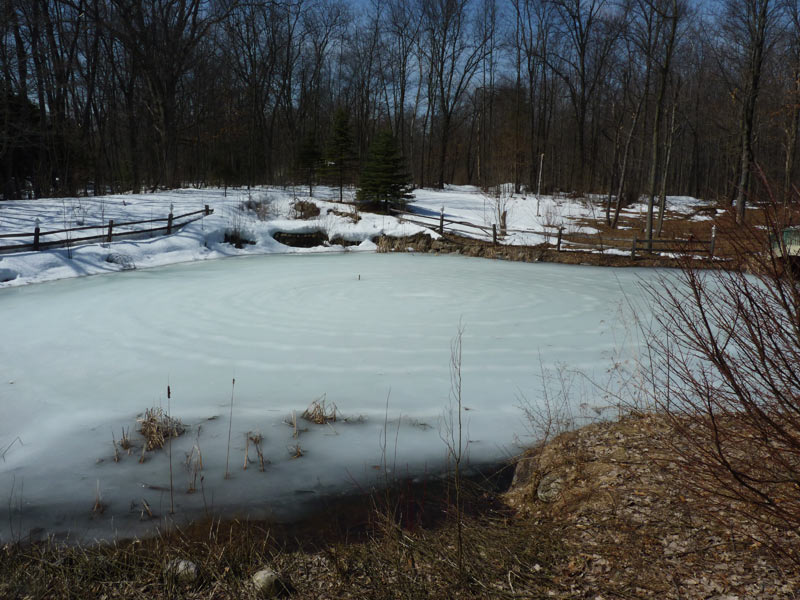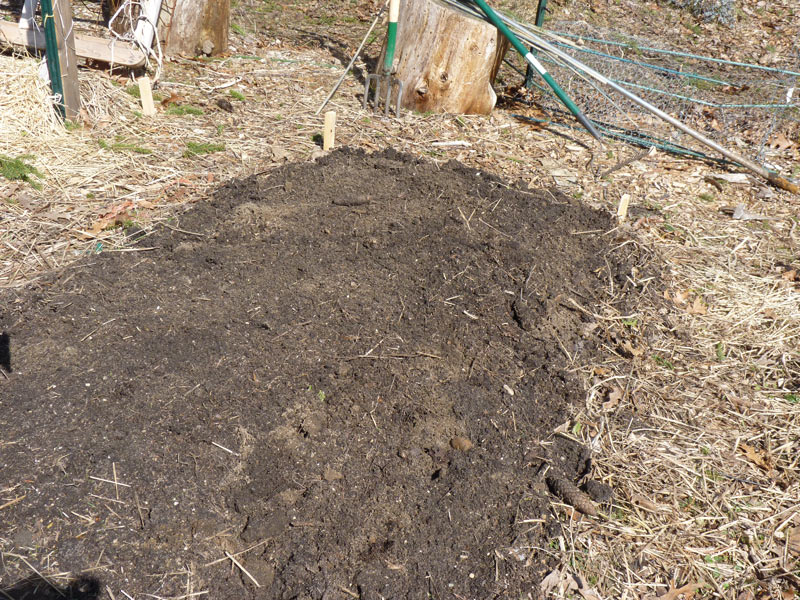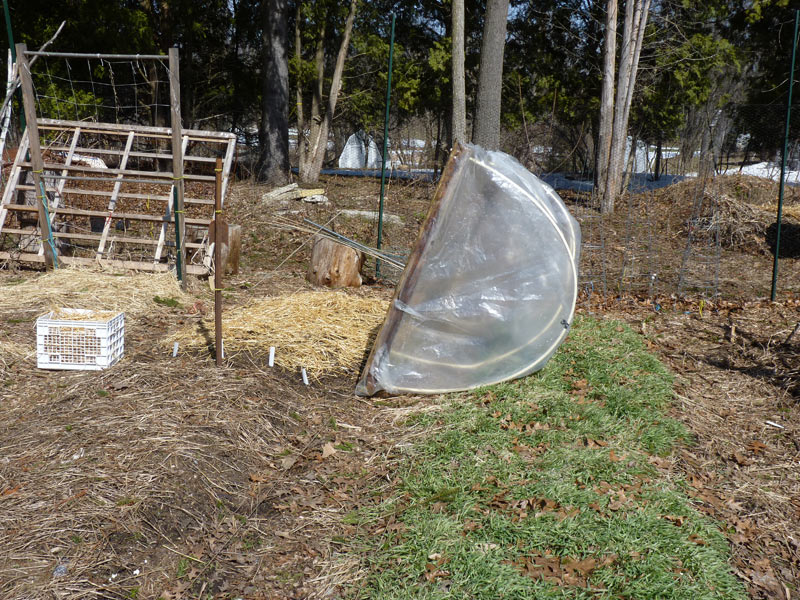The Spring Equinox was a mere week and a half ago, and today, for the first time, it felt like spring. The snows are melting and the warmth is coming. I think its been a long, hard winter for many of us, and not just because of the weather. It was a dark time for many, myself included, and I am very happy to see the sun and feel the warmth again. This post provides an overview of the garden in its current state (March 31st) as well as the surrounding landscape. I’ll conclude the post with some of the things I plan on covering on the blog in the coming year.
The Broader Landscape
The snows are not yet melted, and the lakes and ponds are still frozen over. Here’s an image of the spiral labyrinth I’ve been walking on my pond all winter–its still there, and the ice is still quite thick.

I visited Lake Huron with a few friends yesterday, and likewise, the Great Lakes are still encrusted with ice. Here’s a shot from yesterday at White Rock, on the Southwestern edge of Lake Huron.


Even with all of this ice, however, the land and lakes are slowly thawing.
The Garden and its Magic
Today I spent time out in the garden in the afternoon, and it was a really welcome and nurturing time. I can’t believe how much healing one can gain with only a few hours in the sun and with the plants and soil!
First, the most important discovery–plants under my hoop houses survived. I added an additional layer to their shelter, something called “remay” which is a spun fiber. I added this in early December, after the cold really set in. It goes under the main hoop and above the plants and helps give them one additional layer of protection. This still typically only protects the plants to 5 or 10 degrees or so, however. With the cold winter, and the evenings of -15 and -17, I thought there was no hope for my little hoops.
And yet…look what I found today. You’ll notice in the first picture that the spinach only in the center survived–that’s because the ground freezes from the edges inward. But I realized, as my hoops were covered with over 2′ of snow, that that snow itself must have provided a buffer for the spinach. This likely means that my other zone 6 plants (like my pecan tree back by the circle) had a chance of survival.



I can’t really describe to you the feeling of opening up that hoop house and seeing those living spinach and radish plants. I had given up on them as the hoops had mostly caved in under the heavy snow and ice that I wasn’t able to remove, as the darkness set in. I have always seen the garden as a metaphor for myself, and I’ve had so many cold, dark, barren months recently. Seeing those spinach and radish plants renewed the promise of spring within me….something survived, and soon, it will be giving me further nourishment and strength. It was a profound moment, there in the garden.
All of the fall garden preparation has paid off–the early spring beds are just filled with wonderful soil. I am so pleased to see it, as I have spent years making this soil the best it can be. I moved my 2nd hoop house (the one that wasn’t protecting anything), prepped a bed of lettuce and carrots, direct seeded them, and covered them back up.

One of the other things I wanted to report back on was the effect of the cover crops. With 2+ feet of snow and ice on the ground, all of the soil in the beds is very compacted–its probably 4″ lower than it was in the fall. It appears the red clover died off completely….but the winter rye is the hardiest of plants, and it, of course, survived. Not only did it survive, but it kept my beds covered in it mostly spongy and nice, instead of compacted. The beds with the winter rye are a full 2-3″ higher than those with bare soil or just straw.

I began turning the winter rye under today–it requires a full two weeks of wait time before planting after you turn it under. I’ll work to turn all of it under in the next few weeks–this is a laborious job and one that could be done with petrochemicals, but after the rather lazy winter months, I don’t mind the hard work :). I also like to add some brown matter to the soil to help the bacteria break down the rye–I added some composted leaves (leaf mulch) as I turned. A simple garden fork does this work beautifully (much better than a shovel, which I used to use before I discovered the fork).

Peas germinate at 40 degrees or higher and don’t mind cold soils. I used the garden fork to aerate the garden bed, and reduce soil compaction. I just stuck it into the bed and tilted it a bit to loosen the soil. Then I planted my first succession of peas (Early Alaska, saved from last year) and will plant another succession every two weeks for the next 6 weeks. This will ensure a continual harvest into the early summer. You can see my homemade trellises here as well (they move easily enough to the new bed).

I checked on the garlic I planted in the fall. No sign of sprouting yet!

The last thing I did today was make a new, large compost pile. I had the pile started in the fall, but I pulled out all of the food waste I had stored in my tumbler over the winter, added it to the big pile, and added several layers of leaves, some of the old straw from the garden, etc. The pile is now almost 5′ high and 8′ wide and 4′ long, so it should break down nicely as the weather warms.
Looking Ahead
To conclude this post, I wanted to share a few more of the things that I’m planning on doing more this year:
- Bees! Perhaps the most important news is that this year I am going to be a beekeeper for the first time :). I have the hives, the bees ordered, and the rest of my supplies (suit, foundation, etc) are on their way! I’ve read every book on the subject I can find, joined a beekeeping association, found a bee mentor, have a friend who wants to learn as well, and feel I’m as ready as I’ll ever be. I’ll have a blog post (or three) on the bees soon.
- Garden expansion: I’m adding about 700 square feet of growing space (plus pathways, etc) to the garden this year to accommodate new vegetable and plant varieties. In the fall, I added in numerous additional herb gardens in the front yard, and have seeds started for many new herbs. The big job here will be fencing, and since fencing has been a struggle, I will share some of my experiences!
- Herbalism course. I’m starting Jim McDonald’s four season herbal intensive course this upcoming weekend–expect even more posts on herbalism in the coming months.
- Fermentation and foods: I plan to make my own miso, make more dandelion wine, make other kinds of krauts and fermented foods, and share those processes with you this year.
- Sacred Trees: I’ll keep posting regularly on my research on sacred trees native/naturalized to the Midwest/Great Lakes area. I think this is important work, and I am certainly learning a lot more about the trees as part of this series.
- And lots more! I expect to engage in more natural building, foraging, and many other wonderful sustainable and spiritual activities this year–and I’m excited to share them with you.
I also have some very tragic news on the homesteading front.
- Chooks. In late December, when I was out of town for the holidays, all of my hens passed on to their next life; they made a good meal or two for a hungry raccoon. My beloved rooster, Anasazi, did survive (he has many lives, clearly) and is living at a friend’s house till I can raise more hens. This was a combination of an ice storm, insecure living arrangement, loss of electricity, impassible roads, and a bunch of other things. I have mourned their loss and miss them terribly. But, I look forward to new hens later this year.
I hope that everyone has a wonderful spring–I’d love to hear about how you are enjoying the warmer weather and melting snows and what plans you have for projects this year.



I’m sorry for the loss of your hens 🙁
Excited to see all those future post topics come about, but I especially look forward to the ones about the bees and Sacred Trees! (maybe because they rhyme?)
Will you be planting more winter rye next time after the success of this year?
That’s a really neat picture on the frozen lake! Dressed like that I would have been way to cold to stay outside for more than a few minutes, let alone play a flute while standing on open ice ^_^;; I applaud the effort as well as thank the photographer and subject for capturing and sharing the experience 😀
What an inspired idea to create a labyrinth on a nicely flat, frozen surface. Wouldn’t have had the guts to try it myself, too afraid of falling through >.>;;;
From the wild heart,
~Alainafae
This is such a beautiful and inspiring post! I miss the midwest, even with its rough winter this year. I wish you all the best with your gardening this season and cheers on your surviving foods! I hope you have many, many more healing hours growing with your garden ; ) Peace be with you friend. I look forward to reading so much more from you!
Thank you! I love winter, and this winter was certainly a wild ride. I think my own challenges this past winter made it harder than usual on me (usually I revel in the snow, hehe). But I’m excited about the upcoming season!
Hi Alainafae! For as cold and frozen as it has been, the ice is way strong enough to stand on :). Most years it is in late January or early February. In early 2013, I had a big ice-skating party for my birthday on the pond–it was great, and there were like 12 of us out there all at once. On the bigger lakes around here, people drive their cars on the ice and everything… and it makes the perfect surface.
This year, the pond was the only thing that didn’t have 2+ feet of snow, so if I wanted to walk outside, it was the best option (it only had about 10″ of snow when I first created the labyrinth). I think I might make myself a pair of snowshoes for next year.
I will be planting more winter rye, yes! I can’t believe how well it works–and it makes a wonderful soil.
Loved looking at all the pictures in this one of your emerging spring land 🙂 xox
Thank you brie!
I’m sorry for your loss. I hope you find renewal in this new season. And congrats on the beautiful spinach and successful hoop house protection.
Thank you! 🙂